相变蓄能建筑墙体研究进展
2015-06-09张小松
张小松 夏 燚,3 金 星
(1东南大学能源与环境学院,南京210096)(2东南大学建筑学院,南京210096)(3南京师范大学能源与机械工程学院,南京210042)
相变蓄能建筑墙体研究进展
张小松1夏 燚1,3金 星2
(1东南大学能源与环境学院,南京210096)(2东南大学建筑学院,南京210096)(3南京师范大学能源与机械工程学院,南京210042)
对相变材料在墙体中的封装方式(直接混合、宏观封装、微观封装和定形相变材料封装)、相变材料的种类和物性等方面的研究进行了归纳总结.从实验和模拟2个方面,对相变材料位于墙体表面和墙体内部影响室内环境和建筑能耗的研究进行了综述和评价.分析表明,微观封装和定形相变材料的封装效果较好;墙体用相变材料的相变温度一般在20~30 ℃范围内;相变材料层在墙体中的安装位置可分为墙体表面和墙体内部2种,但相变材料层在墙体内的最优位置并不固定,受相变材料物性、墙体材料以及室内外环境工况的影响.通过相变材料与墙体合理高效的结合,可充分发挥相变材料的高蓄热特性,提高墙体的热性能,达到调节室内环境温度、降低建筑能耗的目的.
相变材料;建筑墙体;蓄热;节能
数据表明,经济的发展带来了能耗的增加,自2009年世界经济危机以来,世界能耗逐年增长,而我国增长速度更快,已成为世界上能耗最大的国家[1].在社会总能耗中,我国建筑运行能耗占约社会总能耗的20%[2],并且也在逐年增大.建筑节能形势紧迫并且潜力巨大,因此建筑节能也已成为国家节能规划的重点.蓄能(热)被认为是实现建筑节能的一种有效方式,它可以缓解热量供求双方在时间、空间和强度上的不匹配[3].蓄热主要有显热蓄热和潜热蓄热2种.显热蓄热主要通过提高固体或液体蓄能介质的温度来达到蓄能的目的,蓄能能力取决于介质比热、温度差值及质量.现有的固体、液体物质中水的比热最大,但相比于蓄能需要而言此比热依然较小,蓄能需要大量的容器并有很好的保温,因此系统效率不高.而潜热蓄热也称作相变蓄热,则被认为是最有效的蓄能方式,通过介质相态的转换从而吸收或放出大量的热能.它能在近似等温或者很小的温度区间内吸收或释放大量的热量.以水为例,水的比热为4.2 kJ/(kg·K),而水的固液相变潜热则为336 kJ/kg.相变材料可分为有机相变材料、无机相变材料和复合相变材料,其中有机相变材料包括石蜡、脂肪酸等,它们具有过冷度小、无相分离、无毒等优点,但也具有易燃、热导率低等缺点;无机相变材料包括水合盐、熔融盐等,它们具有潜热大、不可燃、热导率高等优点,但也有过冷度大、容易相分离、有腐蚀性等缺点;复合相变材料则由有机材料与无机材料复合而成[4].
由于相变材料相变时将吸收或放出大量的热量,若将其应用于建筑围护结构中则可大大提高建筑围护结构的热性能,从而降低室内空气温度的波动,减少冷热负荷,进而达到建筑节能的目的[3].本文对相变材料在墙体中的封装方式、相变材料的种类和物性等方面的研究进展进行了归纳总结,从实验和模拟2个方面,对相变材料位于墙体表面和墙体内部对室内环境和建筑能耗的影响进行了综述和评价.
1 相变材料在墙体中的封装方式
墙体中常用的相变材料为固-液相变材料,由于此类材料会发生固相-液相转变,因此将相变材料应用于墙体内,首先应解决如何封装相变材料从而解决防止其泄露的问题.一般而言,相变材料在墙体中的封装方式有以下几种:
1) 直接混合.即通过直接混合或沉浸的方式将相变材料混入或渗入建筑材料(石膏、水泥、混凝土、砂浆、保温材料等)中,这是最简单的一种封装手段与应用方式.例如,Athienitis等[5]将相变材料渗入到石膏板内,再将该相变材料石膏板用于一个被动式太阳能测试房中.Neeper[6]将不同比例的脂肪酸和石蜡渗入到石膏板内制成一种相变石膏板,并研究了这种相变板的热性能.Hadjieva等[7]在75 ℃的条件下,将混凝土板沉浸到一种水合盐相变材料Na2S2O3·5H2O溶液中,从而得到一种可以用于建筑结构的相变材料板.Evers等[8]先将一种石蜡和一种水合盐类相变材料熔化,再分别将这2种液体喷射到纤维保温材料内,从而制得2种墙体蓄能保温材料.Li等[9]将一种有机相变材料正十九烷和水泥分别以质量比1∶4和1∶1的比例溶入水中,干燥后相变材料会分散到水泥的孔隙中,从而得到一种相变材料复合板.但这种直接封装方式存在泄漏问题,并且对于某些水合盐类相变材料使用效果也不好.
2) 宏观封装.将相变材料封装到金属管、金属球、塑料袋等内部,具体形式有管式、袋式、板式、球式等.例如,Medina等[10]将相变材料装入铜管内,然后将这些铜管放入框架墙中.Ahmad等[11-12]将相变材料放入到聚氨酯板或聚乙烯板的板间空隙中.Bontemps等[13]用玻璃容器封装相变材料.Zalewski等[14]用高分子聚烯烃材料将相变材料封装于类似砖块的构造内.Silva等[15]将相变材料充入钢质胶囊内,再将该胶囊放入多孔砖的孔洞内.图1为宏观封装方式示意图.
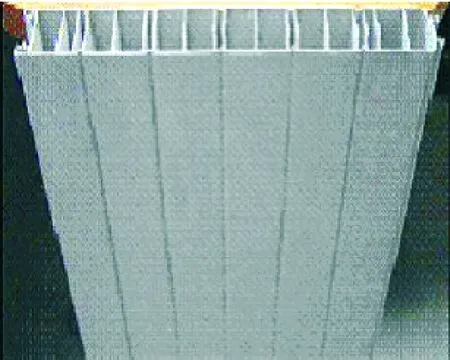
(a) 板间空隙填充封装[12]

(b) 玻璃容器封装[13]

(c) 高分子材料封装[14]

(d) 钢质胶囊填入多孔砖封装[15]
3) 微观封装.将相变材料封装入一个由高分子聚合材料制成的且直径较小(一般1 000 μm以下)的微胶囊中,这种封装方式能较好地解决相变材料的泄露问题.例如,Hawlader等[16]研究了将石蜡微观封装起来的相变胶囊性能,发现该胶囊适合蓄存太阳能.Schossig等[17]将相变材料封装起来,再将这些微胶囊分散到石膏板内,该种微胶囊相变材料具有使用简单、传热性能好等优点.Microtek Laboratories, Inc.生产了一种尺寸为17~20 μm的相变微胶囊,外壁为高分子聚合材料,相变材料的质量分数为85%~90%[18].Konuklu等[19]用尿素、三聚氰胺、明胶等材料作为囊材,将辛酸包裹起来,制作出一种微胶囊相变材料.图2为微观封装方式的扫描电镜图片及示意图.
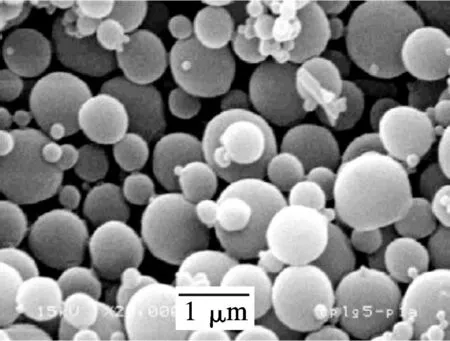
(a) 石腊相变胶囊[16]

(b) 用于石膏板的微胶囊[17]
4) 定形相变材料封装.该封装方式是将相变材料(芯材)和高分子支撑与封装材料(囊材)复合形成定形相变材料构件,再将该构件应用于墙体.支撑材料一般为高分子材料如高密度聚乙烯(HDPE)及热塑弹性体(SBS),在微观尺度内将定形相变材料包裹交联起来.支撑材料熔点较高,在复合材料中形成空间网状结构,对作为芯材的相变材料起微封装和支撑作用.只要工作温度低于高分子囊材的熔点,作为芯材的相变材料发生固-液相变时就不会流出,整个复合相变材料能保持原来的形状不变并具有一定的强度,降低了泄漏的可能性[20].近年来国内外不少研究机构在定形相变材料的制备、性能优化、应用等方面做了很多研究[21-26],图3为定形相变材料的外观及扫描电镜照片.
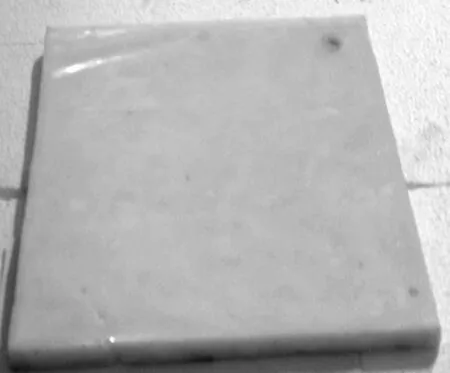
(a) 外观
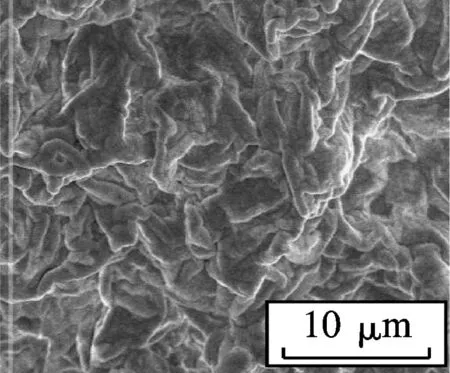
(b) 电镜照片
2 相变材料特性及安装位置
近些年,国内外专家学者对相变蓄能建筑墙体进行了模拟和实验研究,将相变材料应用于建筑墙体,可起到以下作用[27-29]:① 增大墙体热容,从而降低传入室内的最大热流,延迟最大热流的到来时间,起到“削峰延迟”作用;② 降低室内温度波动,使室内温度长时间维持在需求的温度范围内,并减少设备启停次数和运行时间;③ 可以结合可再生能源(太阳能、风能等)为房间提供免费冷量或热量.
表1总结了近年来用于建筑墙体实验研究的相变材料种类及熔点、潜热值.从表中可以看出,用于墙体的相变材料的相变温度基本处于20~30 ℃区间内,而一般研究也认为,为了更好地调节室内温度,选择的相变材料的相变温度应接近于室温.
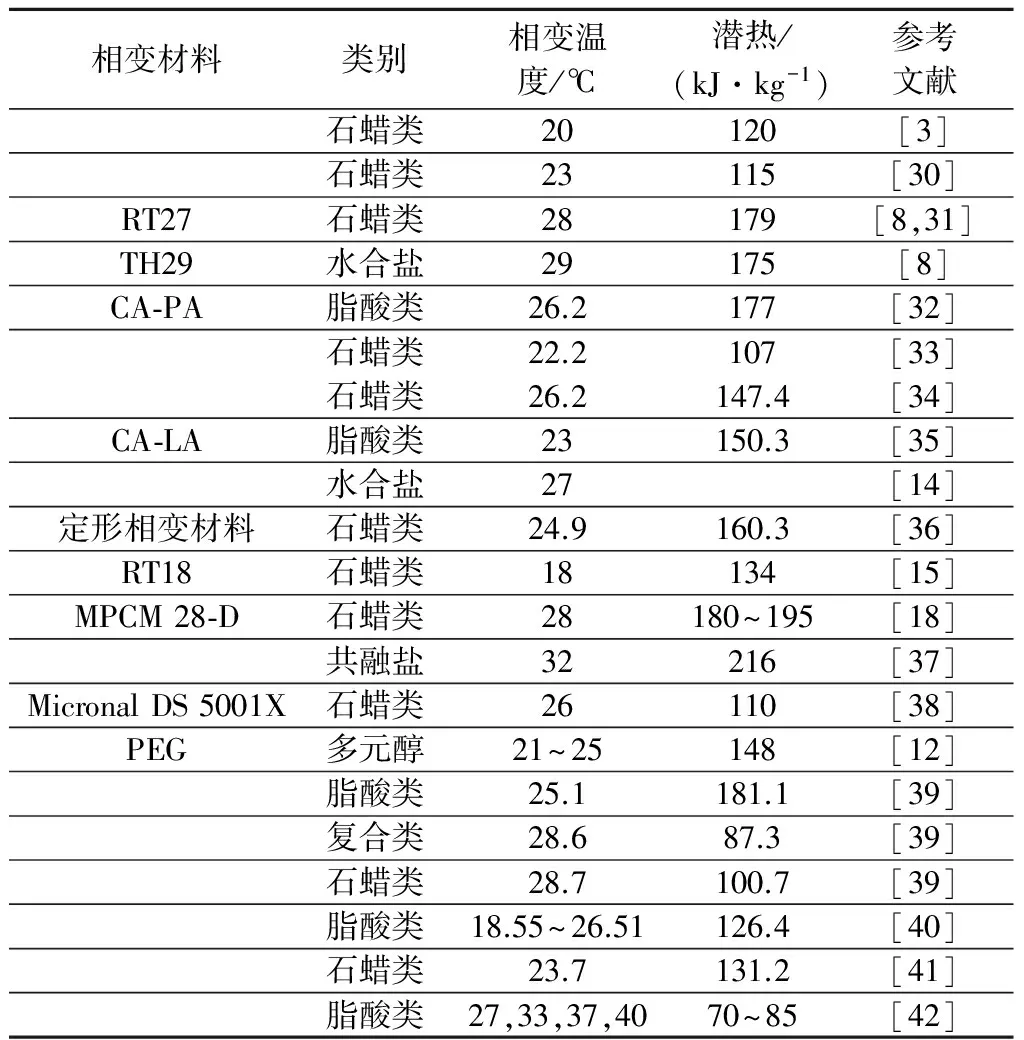
表1 墙体用相变材料种类及物性
相变材料在墙体内的安装位置可分为两类:① 位于墙体表面,将相变材料通过各种方式混入石膏板、砂浆内,然后将制成的相变墙板构件安装于墙体表面,一般内表面居多;② 位于墙体内部,将封装好的相变材料构件放入墙体构造层内,或者将相变材料与混凝土、砖块、保温材料混合后直接用于墙体.
1) 相变材料层位于墙体表面
2) 相变材料层位于墙体内部
Kuznik等[33]将制得的相变蓄能板放置于墙体的保温材料层和内表面石膏板之间,并利用搭建的测试房间进行对比实验,该房间内的温度、太阳辐射强度等参数均可严格控制,因此每日的测试工况可重复.分别进行夏季、冬季以及过渡季节中某一天的实验,结果表明相变墙板强化了室内自然对流,使得室内的舒适性提高.Medina等[10]将装有相变材料的铜管放置于墙体保温层内并贴近房间内表面的OSB板,利用搭建的2个测试房间对比了墙体有无相变材料时的热性能,测试结果表明,当相变材料质量分数(相比于内墙板)为20%时,墙体峰值热流可降低62%.多孔砖具有轻质、热阻大等特点,而其内部的孔洞也可用于放置相变材料.Silva等[15]和Alawadhi[48]分别研究了在多孔砖的孔洞内充注相变材料后的热性能,结果表明这些相变材料砖都具有很好的温度、热流调控效果,而相变材料在多孔砖内的位置也会影响其热性能.Huang等[49]研究了在外墙的砖块层和混凝土层之间设置一层相变材料层的墙体的蓄热性能和温度调控性能.模拟结果显示,在英国一月份的天气条件下,设有20 mm相变材料层和20 mm空气层的墙体可以使内墙表面温度满足热舒适要求,并可防止内部凝露.Castell等[50]将制得一种石蜡类相变材料板放置于墙体中的多孔砖与保温材料之间,并进行实验测试,结果表明墙体内安装有相变材料的房间内最高温度可降低1 ℃,而且温度波动较小,在整个夏季,房间电能消耗降低约15%.
图4列举了相变材料与墙体的结合方式.
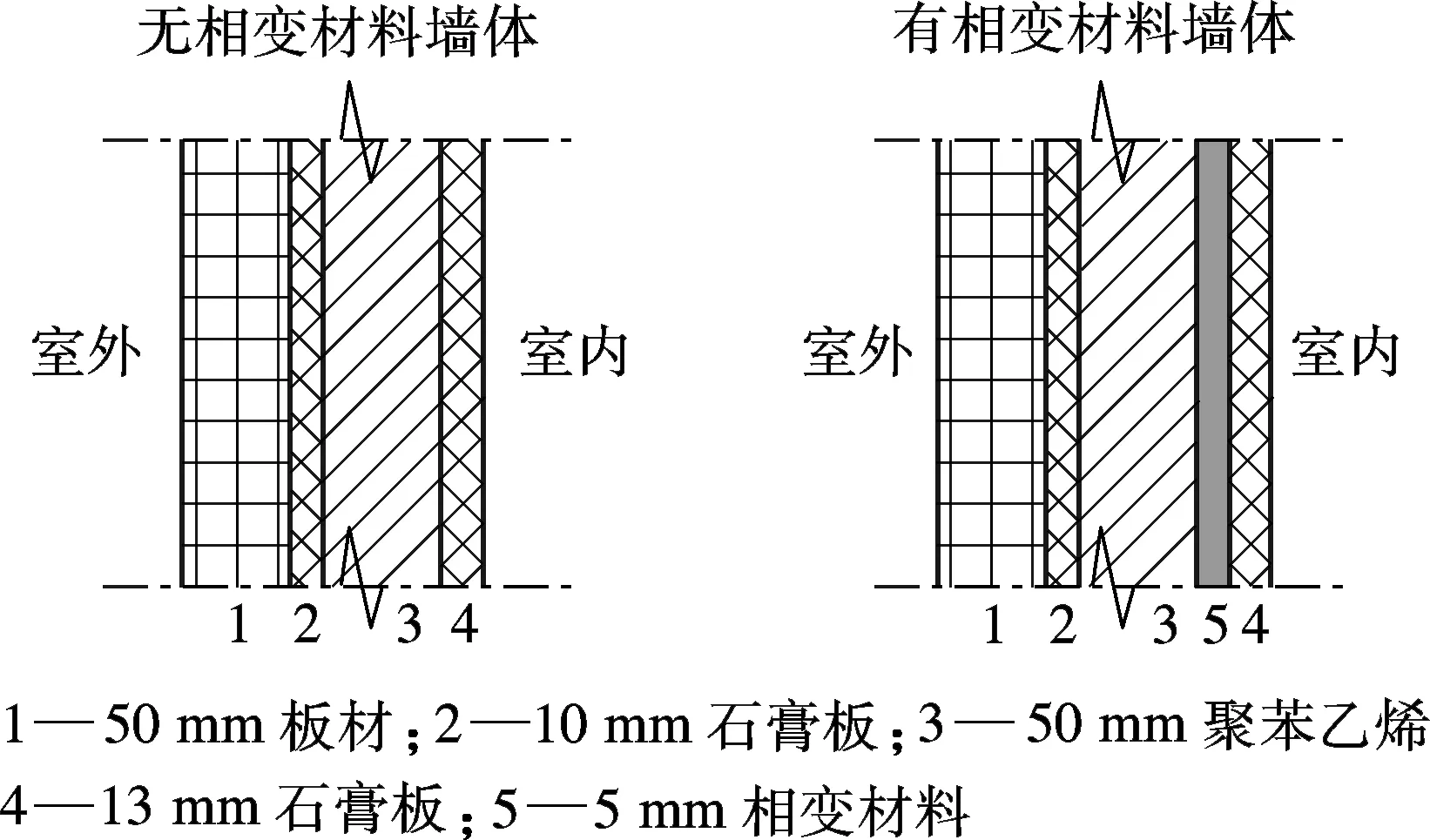
(a) 相变材料位于保温和内墙之间[33]
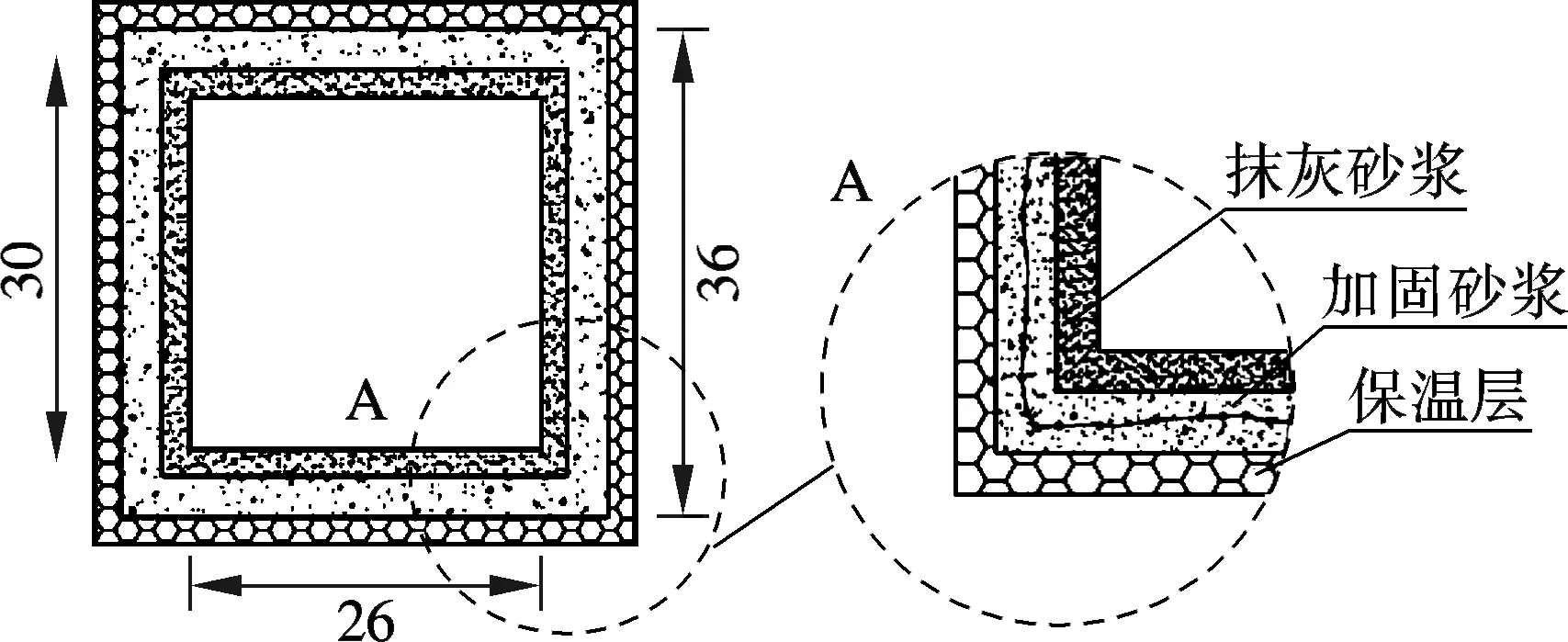
(b) 相变胶囊掺入内墙抺灰砂浆[43](单位:mm)
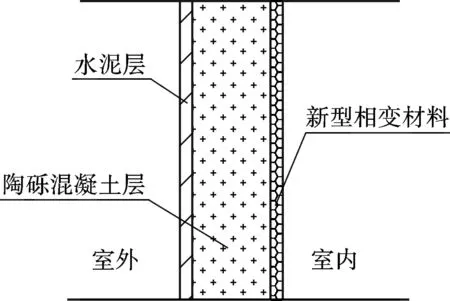
(c) 内壁相变墙板[44]
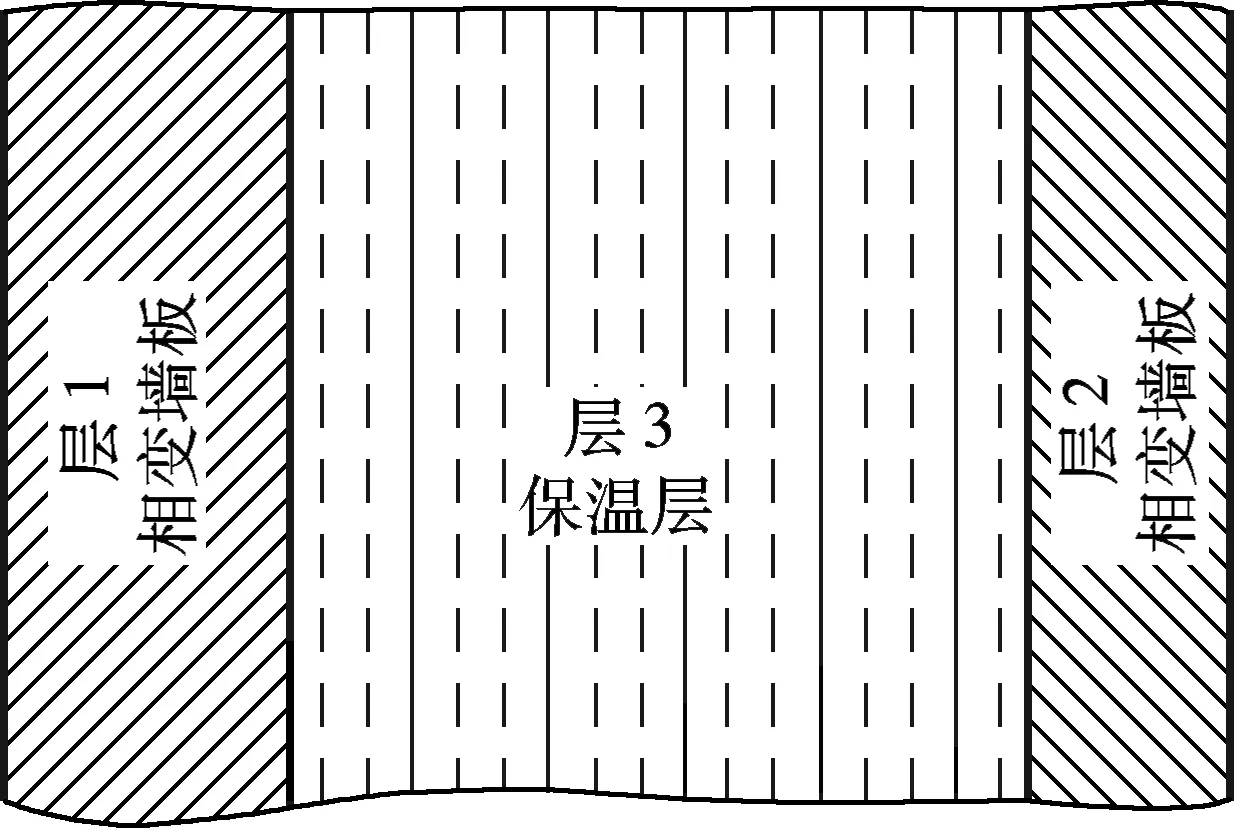
(d) 内外侧双层相变墙板[45]

(f) 多孔砖充注相变材料[48]
相变材料在墙体中最优的安装位置是不能一概而论的,与相变材料物性(特别是相变温度)、墙体结构以及环境工况有关,在最适宜的位置相变材料应能在一天之内完成熔化-凝固相变循环,也就是说相变材料能发挥最大的蓄能能力.由于室内外温度的不同,围护结构内各点的温度变化也不相同,假设围护结构是由一层层很薄的材料组合而成,那么在一定的工况下,当相变材料位于围护结构中的某些位置时,在升温和降温过程中相变材料所经历的温度变化范围能包含其相变温度区间或与其相变温区重叠较多,此时相变材料能吸收并释放较多的热量,有些位置则由于相变材料所经历的温度变化范围与其相变温区重叠较小而不能很好地吸热或放热.因此相变材料位置对墙体热性能会有很大影响.针对这个问题,Jin等[51]研究了将相变材料板放置于保温材料层中间或贴近保温材料层等不同位置时对墙体热性能提升的影响,实验结果表明相变材料层位置对墙体热性能影响很大,墙体中存在着最优的相变材料层位置,在该最优位置,通过墙体的峰值热流可降低41%.
3 结语
通过将相变材料与墙体合理高效结合,可充分发挥相变材料的高蓄热性,提高墙体的热性能,进而达到调节室内环境温度、降低建筑能耗的目的,是被动式建筑节能技术中的一项有效手段.但相变材料在墙体中的应用还存在不少问题,需进一步研究和解决:在材料自身方面应研制开发出更便宜的相变材料以提高其经济性,提高相变材料的耐久性、导热性以及封装方式的可靠性;在蓄能墙体热性能提升方面还应研究实际环境工况下相变材料层的最优位置,并结合特定气候条件及实际的建筑墙体结构,针对不同的相变材料及安装位置,分别选择最适宜的相变材料等.
References)
[1]Finley M. BP statistical review of world energy[EB/OL].(2013)[2015-03]. http://www.bp.com.2013.
[2]江亿, 彭琛, 燕达. 中国建筑节能的技术路线图 [J]. 建设科技, 2012 (17):12-19.
[3]林坤平. 相变蓄能建筑构件应用原理和效果研究 [D]. 北京: 清华大学建筑学院, 2006.
[4]Sharma A, Tyagi V V, Chen C R, et al. Review on thermal energy storage with phase change materials and applications [J].RenewableandSustainableEnergyReviews, 2009, 13(2):318-345.
[5]Athienitis A K, Liu C, Hawes D, et al. Investigation of the thermal performance of a passive solar test-room with wall latent heat storage [J].BuildingandEnvironment, 1997, 32(5):405-410.
[6]Neeper D A. Thermal dynamics of wallboard with latent heat storage [J].SolarEnergy, 2000, 68(5): 393-403.
[7]Hadjieva M, Stoykov R, Filipova T Z. Composite salt-hydrate concrete system for building energy storage[J].RenewableEnergy, 2000, 19(1/2): 111-115.
[8]Evers A C, Medina M A, Fang Y. Evaluation of the thermal performance of frame walls enhanced with paraffin and hydrated salt phase change materials using a dynamic wall simulator [J].BuildingandEnvironment, 2010, 45(8):1762-1768.
[9]Li H, Liu X, Fang G Y. Preparation and characteristics of n-nonadecane/cement composites as thermal energy storage materials in buildings [J].EnergyandBuildings, 2010, 42(10): 1661-1665.
[10]Medina M A, King J B, Zhang M. On the heat transfer rate reduction of structural insulated panels (SIPs) outfitted with phase change materials (PCMs) [J].Energy, 2008, 33(4):667-678.
[11]Ahmad M, Bontemps A, Sallée H, et al. Experimental investigation and computer simulation of thermal behaviour of wallboards containing a phase change material [J].EnergyandBuildings, 2006, 38(4): 357-366.
[12]Ahmad M, Bontemps A, Sallée H, et al. Thermal testing and numerical simulation of a prototype cell using light wallboards coupling vacuum isolation panels and phase change material [J].EnergyandBuildings, 2006, 38(6): 673-681.
[13]Bontemps A, Ahmad M, Johannés K, et al. Experimental and modelling study of twin cells with latent heat storage walls[J].EnergyandBuildings, 2011, 43(9): 2456-2461.
[14]Zalewski L, Joulin A, Lassue S, et al. Experimental study of small-scale solar wall integrating phase change material[J].SolarEnergy, 2012, 86(1): 208-219.
[15]Silva T, Vicente R, Soares N, et al. Experimental testing and numerical modelling of masonry wall solution with PCM incorporation: a passive construction solution[J].EnergyandBuildings, 2012,49(2): 235-245.
[16]Hawlader M N A, Uddin M S, Khin M M. Microencapsulated PCM thermal-energy storage system[J].AppliedEnergy, 2003, 74(1/2): 195-202.
[17]Schossig P, Henning H M, Gschwander S, et al. Micro-encapsulated phase-change materials integrated into construction materials[J].SolarEnergyMaterialsandSolarCells, 2005, 89(2/3): 297-306.
[18]Lai C, Chen R H, Lin C Y. Heat transfer and thermal storage behaviour of gypsum boards incorporating micro-encapsulated PCM[J].EnergyandBuildings, 2010, 42(8): 1259-1266.
[19]Konuklu Y, Unal M, Paksoy H O. Microencapsulation of caprylic acid with different wall materials as phase change material for thermal energy storage [J].SolarEnergyMaterialsandSolarCells, 2014, 120(1):536-542.
[20]周国兵, 张寅平, 林坤平, 等. 定形相变贮能材料在暖通空调领域的应用研究 [J]. 暖通空调, 2007, 37(5): 27-32. Zhou Guobing, Zhang Yinping, Lin Kunping, et al.Application of shape-stabilized phase change materials for energy storage in HVAC field [J].HeatingVentilating&AirConditioning, 2007, 37(5): 27-32. (in Chinese)
[21]汪意, 杨睿, 张寅平,等. 定形相变材料的研究进展 [J]. 储能科学与技术, 2013, 2(4):362-368. Wang Yi, Yang Rui, Zhang Yinping,et al. Recent progress in shape-stabilized phase change materials [J].EnergyStorageScienceandTechnology, 2013, 2(4):362-368. (in Chinese).
[22]梁辰, 闫全英, 张林,等. 墙体储能用定形相变石蜡储热性能的实验研究 [J]. 太阳能学报, 2009, 30(12):1627-1630. Liang Chen, Yan Quanying, Zhang Lin, et al. Thermal performance analysis of shape-stabilized phase change paraffin used in the wall [J].ActaEnergiaeSolarisSinica, 2009, 30(12):1627-1630. (in Chinese)
[23]Cai Y B, Wei Q F, Huang F L, et al. Preparation and properties studies of halogen-free flame retardant form-stable phase change materials based on paraffin/high density polyethylene composites [J].AppliedEnergy, 2008, 85(8): 765-775.
[24]Sari A, Karaipekli A. Preparation, thermal properties and thermal reliability of palmitic acid/expanded graphite composite as form-stable PCM for thermal energy storage [J].SolarEnergyMaterialsandSolarCells, 2009, 93(5): 571-576.
[26]Zhou G B, Zhang Y P, Zhang Q L, et al. Performance of a hybrid heating system with thermal storage using shape-stabilized phase-change material plates[J].AppliedEnergy, 2007, 84(10): 1068-1077.
[27]Pasupathy A, Velraj R. Effect of double layer phase change material in building roof for year round thermal management [J].EnergyandBuildings, 2008, 40(3):193-203.
[28]王馨, 张寅平, 肖伟, 等. 相变蓄能建筑围护结构热性能研究进展[J]. 科学通报, 2008, 53(24): 3006-3013.
[29]Zhang Y, Lin K, Jiang Y, et al. Thermal storage and nonlinear heat-transfer characteristics of PCM wallboard [J].EnergyandBuildings, 2008, 40(9):1771-1779.
[30]Kosny J, Kossecka E, Brzezinski A, et al. Dynamic thermal performance analysis of fiber insulations containing bio-based phase change materials (PCMs) [J].EnergyandBuildings, 2012, 52(3):122-131.
[31]Borreguero A M, Carmona M, Sanchez M L, et al. Improvement of the thermal behaviour of gypsum blocks by the incorporation of microcapsules containing PCMS obtained by suspension polymerization with an optimal core/coating mass ratio [J].AppliedThermalEngineering, 2010, 30(10):1164-1169.
[32]Sayyar M, Weerasiri R R, Soroushian P, et al. Experimental and numerical study of shape-stable phase-change nanocomposite toward energy-efficient building constructions[J].EnergyandBuildings, 2014, 75(2):249-255.
[33]Kuznik F, Virgone J. Experimental assessment of a phase change material for wall building use [J].AppliedEnergy, 2009, 86(10):2038-2046.
[34]Shi X, Memon S A, Tang W C, et al. Experimental assessment of position of macro encapsulated phasechange material in concrete walls on indoor temperatures and humidity levels [J].EnergyandBuildings, 2014, 71(3):80-87.
[35]Lü Shilei, Feng Guohui, Zhu Neng, et al. Experimental study and evaluation of latent heat storage in phase change materials wallboards [J].EnergyandBuildings, 2007, 39(10):1088-1091.
[36]Yan Quanying, Huo Ran, Li Lisha. Experimental study on the thermal properties of the phase change material wall formed by different methods [J].SolarEnergy, 2012, 86(10):3099-3102.
[37]Carbonari A, de Grassi M, di Perna C, et al. Numerical and experimental analyses of PCM containing sandwich panels for prefabricated walls [J].EnergyandBuildings, 2006, 38(5):472-483.
[38]Oliver A. Thermal characterization of gypsum boards with PCM included: Thermal energy storage in buildings through latent heat [J].EnergyandBuildings, 2012, 48(5):1-7.
[39]闫全英, 霍冉, 张林. 定形相变墙体传热性能和力学性能的实验研究 [J]. 建筑节能, 2011, 39(9):42-46. Yan Quanying, Huo Ran, Zhang Lin. Experimental research on the heat transfer and mechanical property of shape-stabilized phase change material walls [J].BuildingEnergyEfficiency, 2011, 39(9):42-46. (in Chinese)
[40]冯国会, 韩淑伊, 刘馨,等. 相变墙房间夏季夜间通风效果实验 [J]. 沈阳建筑大学学报:自然科学版, 2013, 29(4): 693-697. Feng Guohui, Han Shuyi, Liu Xin, et al. Experimental study on night ventilation effect in a phase change wall room in summer [J].JournalofShenyangJianzhuUniversity:NaturalScience, 2013, 29(4): 693-697. (in Chinese)
[41]陈超, 果海凤, 周玮. 相变墙体材料在温室大棚中的实验研究 [J]. 太阳能学报, 2009, 30(3):287-293. Chen Chao, Guo Haifeng, Zhou Wei. Experimental research of the composite phase change material in greenhouse [J].ActaEnergiaeSolarisSinica, 2009, 30(3):287-293. (in Chinese)
[42]邓安仲, 李胜波, 庄春龙,等. 相变储热轻质围护结构夏季隔热节能的实验研究 [J]. 暖通空调, 2009, 39(9):75-79. Deng Anzhong, Li Shengbo, Zhuang Chunlong, et al. Experimental study of heat insulation and energy performance of lightweight PCM building envelope [J].HeatingVentilating&AirCondition, 2009, 39(9):75-79. (in Chinese)
[44]Chen C, Guo H, Liu Y, et al. A new kind of phase change material (PCM) for energy-storing wallboard[J].EnergyandBuildings, 2008, 40(5): 882-890.
[45]Diaconu B M, Cruceru M. Novel concept of composite phase change material wall system for year-round thermal energy savings [J].EnergyandBuildings, 2010, 42(10):1759-1772.
[46]Voelker C, Kornadt O, Ostry M. Temperature reduction due to the application of phase change materials [J].EnergyandBuildings, 2008, 40(5):937-944.
[47]Zhou Guobing, Yang Yongping, Wang Xin, et al. Numerical analysis of effect of shape-stabilized phase change material plates in a building combined with night ventilation [J].AppliedEnergy, 2009, 86(1):52-59.
[48]Alawadhi E M. Thermal analysis of a building brick containing phase change material [J].EnergyandBuildings, 2008, 40(3):351-357.
[49]Huang M J, Eames P C, Hewitt N J. The application of a validated numerical model to predict the energy conservation potential of using phase change materials in the fabric of a building [J].SolarEnergyMaterialsandSolarCells, 2006, 90(13):1951-1960.
[50]Castell A, Martorell I, Medrano M, et al. Experimental study of using PCM in brick constructive solutions for passive cooling [J].EnergyandBuildings, 2010, 42(4):534-540.
[51]Jin Xing, Medina M A, Zhang Xiaosong. On the importance of the location of PCMs in building walls for enhanced thermal performance [J].AppliedEnergy, 2013, 106(11):72-78.
Review on phase change material building walls
Zhang Xiaosong1Xia Yi1,3Jin Xing2
(1School of Energy and Environment, Southeast University, Nanjing 210096, China) (2School of Architecture, Southeast University, Nanjing 210096, China) (3School of Energy and Mechanical Engineering, Nanjing Normal University, Nanjing 210042,China)
The encapsulation methods for phase change materials (PCMs) in building walls including direct-mixing, macro-encapsulation, micro-encapsulation, and shape-stabilized PCMs, the kinds of PCMs and their properties are reviewed. The PCMs can be located at the wall surface or inside the wall, the effects of PCMs in both cases on the indoor environment and building energy consumption are evaluated respectively based on experiments and simulation research. The results show that the encapsulation effects of the micro-encapsulation and shape-stabilized PCMs are better. The phase change temperatures of PCMs used in the building walls are usually 20 to 30 ℃. The optimal location of PCMs is not fixed. It is affected by the properties of PCMs, wall material, indoor environment and outdoor environment. By integrating PCMs with the building walls effectively, the high thermal storage property of PCMs can be fully developed and the thermal performance of the building walls is improved. Thus, the indoor air temperature is adjusted and the building energy consumption is reduced.
phase change material; building walls; thermal storage; energy conservation
10.3969/j.issn.1001-0505.2015.03.035
2015-01-20. 作者简介: 张小松(1960—),男,博士,教授,博士生导师,rachpe@seu.edu.cn.
国家自然科学基金重点资助项目(51036001)、“十二五”国家科技支撑计划资助项目(2011BAJ03B14).
张小松,夏燚,金星.相变蓄能建筑墙体研究进展[J].东南大学学报:自然科学版,2015,45(3):613-618.
10.3969/j.issn.1001-0505.2015.03.035
TK124
A
1001-0505(2015)03-0612-07
